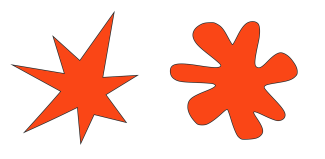The bouba-kiki effect characterizes the association between the visual form and the pronunciation of the name we might give it.
It is a rather strange visual and auditory phenomenon.
Take a close look at the two images below. If you had to give them a name, which would you call “KIKI” and which “BOUBA”?

The bouba-kiki phenomenon is a simple association between certain shapes and speech sounds. In a way, it is one of the exceptions to the general idea that words have no connection with their meaning.
The word “table”, for example, has nothing to do with the object itself. Exceptions to this principle include onomatopoeia, with “meow” having a direct link to a cat’s meow. In the test above, chances are you have assigned the name “KIKI” to the pointed shape and “BOUBA” to the round one. This “bouba-kiki” effect, described since the early 20th century, is one of those exceptions.
Incongruous as it may seem at first glance, the bouba-kiki phenomenon is directly involved, for example, in the invention of brand names. Finding a “selling” name for a car or a drug requires thinking about the sounds, images, emotions and memories that the name will evoke in the minds of potential buyers.
Conscious Thought or Automatic Association?
Is this association between shapes and sounds the result of conscious thought, in response to a particular question posed by the experimenter, or does it reflect a close, automatic cerebral link between vision and hearing?
To answer this question, researchers at Paris Brain Institute presented participants with a sound (“kiki”, “bouba”, “keti”, “lujo”, etc.) and a shape, pointed or round, and asked them to make two decisions:
- is the shape pointed or round?
- does the sound contain an o or an i?
These questions were answered by pressing buttons.
During some phases of the experiment, the same hand was used to respond to “matching” sounds and shapes, for example, round shapes and the o sound, while at other times the same hand was used for “conflicting” sounds and shapes, for example, pointed shapes and the o sound.
| Matching shapes and sounds | Conflicting shapes and sounds |
| Round shape / “o” sound | Round shape / “i” sound |
| Pointed shape / “i” sound | Pointed shape / “o” sound |
In the experiment, participants took longer to respond and made more errors when the same hand had to respond to shapes and sounds that “didn’t go together” (conflicting), validating the hypothesis that it is harder to respond by going against automatic associations.
The Mechanisms of the Bouba-Kiki Effect
The scientists then explored the mechanisms of the bouba-kiki effect using functional MRI studying brain activations during the presentation of a shape, a sound, or the association of a shape and a sound, matching or not matching.
They observed the effects of congruence between sounds and shapes in different parts of the brain: in prefrontal regions associated with voluntary and reflective decisions, but also in the auditory cortex and visual cortex.
Activations in the regions responsible for auditory and visual perception suggest that we do not automatically see a shape and hear a sound in the same way, depending on whether they have some kind of correspondence that crosses the boundaries of the senses.
Sources :
https://pubmed.ncbi.nlm.nih.gov/30503933/
Peiffer-Smadja N, Cohen L. Neuroimage. 2018 Nov 29
- Magnetic resonance imaging (MRI) :
- Imaging technique used to obtain 2 or 3-dimensional views of organs or limbs.

